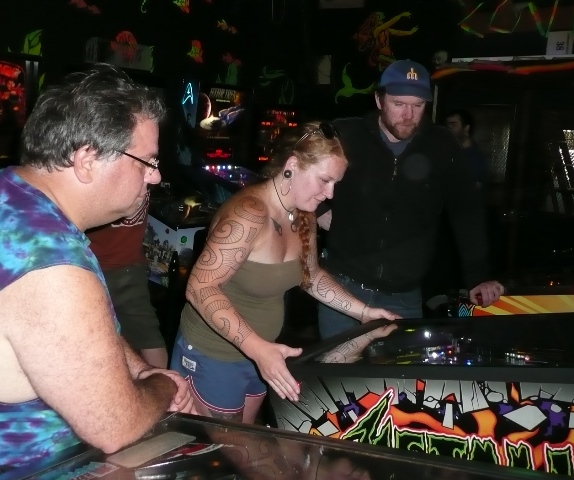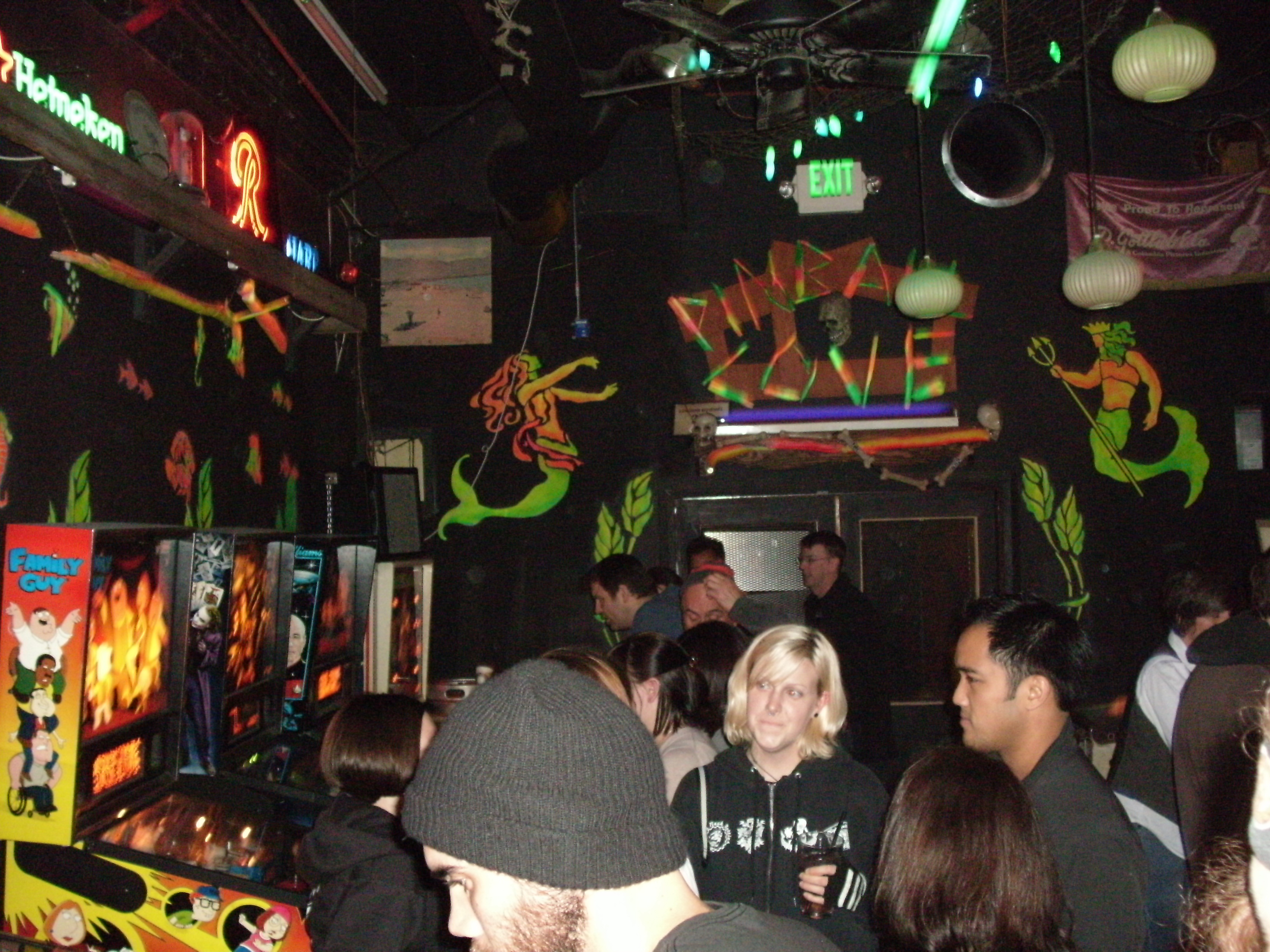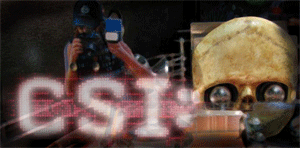by Gordon
Readers of Skill Shot may have noticed that Seattle has a lot of pinball tournaments. Whether at bars, private homes, or public arcades, if you play pinball you’re bound to come across either a tournament while it is happening or a flyer for one that is going to happen soon. This is a good thing because tournaments are fun and they make pinball more exciting than any other arcade game. But for new players, or those who have never participated in a tournament, they can be a little intimidating.
Head-to-Head pinball tournaments are popular in Seattle and the kind of contest you will find in bars like Shorty’s and at the Annual Georgetown Pinball Tournament (which is held at multiple bars). Head-to-Head tournaments put two players against each other in what is a best two-out-of-three match-up. During a single elimination Head-to-Head tournament, the winners keep advancing until there are only two players left for the final game that decides the winner.
In a Double Elimination Head-to-Head tournament, two different brackets are used: a winners’ bracket and a losers’ bracket. The first time a player loses they move into the losers’ bracket and continue to play matches (against other losers) until they lose again and are eliminated from the tournament (hence the name Double Elimination). The players in the losers’ bracket keep advancing until there is only one player left, and the top loser then plays against the final winner from the winners’ bracket. During the final match of a Double Elimination Tournament, the final loser has to win two of the games while the final player from the winners’ bracket only has to win one.
Yet another variation in Head-to-Head is sudden-death, which is simply a single game match instead of the best-of-three. This version is mostly used when time is running out (because the bars close at 2AM).
For more casual tournaments that happen regularly (such as in pinball leagues), the Vancouver Regional Pinball Association style of tournament is popular. The VRPA league point system was developed by Eden Stamm of Vancouver BC, and is a group/point format that has been adapted by many and is especially good for social groups and pinball leagues.
The basics: During the qualifying rounds of the tournament, participants are divided by their skill level into groups of three or four to play a series of matches. Players are then awarded points according to how they placed during each match of the series (1st place gets 7 points, 2nd place gets 5 points, etc). At the end of the qualifying rounds, the total number of points each player acquired are added up to determine who goes on to the next round, ultimately leading to the final match-up that determines the winner of the tournament.
The points that all participants received at past events are averaged together and are carried over to the next (league) tournament so that the players with the highest rankings/number of points can be grouped together. This system is a way of making tournaments in a regular group setting a bit more fair, as it usually places players against each other who have similar pinball skills and insures that all participants have a chance to get further in the qualifying rounds, as opposed to the more random head-to-head style, where a first time player could potentially be matched against a champion.
The Seattle Pinball League uses a version of the VRPA style where the points gained from past tournaments are averaged to determine a player’s ranking. But instead of awarding points gained from each individual match, SPL points are awarded according to how a participant placed in each individual tournament. SPL does it this way because the host of each tournament has the ability to decide what kind of tournament style they wish to have (at their house). Many of the SPL tournaments are done in the VRPA style, but occasionally a tournament style is chosen where counting points during matches is impractical, such as a Round Robin tournament (where only a single point is awarded during each match). While this system may seem confusing at first, like the VRPA, the SPL averages the rankings of the players this way to insure that all members of the league have an equal chance to compete regardless of their skill level.
The Northwest Pinball Championship is the yearly tournament held at PAGS (the Northwest Pinball and Gameroom Show). This is an Open Qualifying tournament where participants buy an entry for the qualifying rounds, which allows them to play one of the designated 7 machines set aside specifically for the tournament. Once their game has been played, the score is recorded and compared to that of the other players, with the highest scorers receiving specified points for how they placed at the end of the qualifying rounds (which end at midnight on Saturday). On Sunday the players with the most points advance to the tournament’s final matches, where the champion is determined by the player with the most points (usually the winner of the final match).
Because this is an open qualifying tournament, contestants are free to purchase entry games as often as they want, with their highest score on any particular machine being the one that is counted. Often players will continuously play qualifying games during the event in order to maintain (or surpass) their ranking on that game. Besides the NW Pinball Championship, PAGS also has other side contests, such as a classics tournament (held on older machines), the highest ranking woman, the highest qualifying score, and a tournament for novice players.
One of the most influential pinball tournaments in the country, the World Pinball Championship, is hosted each year in Pennsylvania by the Professional /Amateur Pinball Association. This is an Open Qualifying tournament held at the PAPA facility, which is used almost exclusively for this event and maintains over 400 pinball machines. PAPA has an extensive rule set for the tournament (over 20 pages) and many of the specific rules concerning game play, machine settings, malfunctions, and player conduct have been adopted by other pinball tournaments around the world (including PAGS and VRPA).
Although many pinball tournaments use the PAPA rules governing the machines and players, it’s the rules of the qualifying rounds at PAPA that can truly boggle the mind. Participants buy an entry in the qualifying round, and then play a total of five different pins (from 10 or 11 designated games). Once they are finished with the five games, their scores are used to determine their ranking on each individual machine and these rankings are then awarded points which are added together to determine an individual entry’s total points. Because the qualifying rounds are continuously happening, it is likely that an individual’s ranking on a particular pin will decrease as the tournament progresses, unless they get a really high score.
Since each entry contains the total scores of five games, each time a player submits a new entry it is possible for them to affect their previous ranking on a pin and also lower their previous points. Their earlier scores are not omitted, no matter how many times they may play a particular machine and each individual entry is considered unique unto itself. While it is not possible for contestants to void a single game, they are allowed to void a whole entry, and this necessitates a strategic game play. While it certainly is a confusing system, it was developed by PAPA as a way to award consistently good players and once the qualifying rounds are over they go back to scoring individual players and their rankings in a more recognizable manner. (Whew!)
Needless to say, pinball tournaments can be as easy or as complicated as the organizer wishes them to be. They may seem intimidating at first but new players shouldn’t be afraid to give them a try, because playing at tournaments is a fun way to learn more about pinball and a good way to meet other people who also love this great sport!
Other Pinball Tournament games and styles:
PIN Golf. Organizers set out (18) pins and then pick a score (par) for each. Players then try to reach that score in the fewest balls (strokes) possible. The winner is the person who uses the lowest number of balls when totaled after all the games are played (just like golf). A danger of this style of tournament is when the scores for the machines are set too high and players need many balls to reach it. If a player needs more than 3 (or 5) balls to hit the target score then the previous game total must be computed into the next game’s score.
Round Robin: A tournament where all participants play against each other, with the winner being determined by who has won the most matches. This style works best when there is a limited number of players and a lot of pinball machines, because it can last a long time. It was recently used at the Tiger Lounge during the Galactic Girl release party.
The Ballard Pinball Tournament: Pub crawl style. Head-to-Head, double eliminations held at a series of bars in the Ballard neighborhood. Players in the losers’ bracket often found themselves playing their rounds in the least desirable locations! (aka places with broken pins)
Price is Right: A specific score is chosen on each game and players must get as close as they can to that score without going over. Come on down!
Siamnese Twin Half and Half: Two-player teams go head-to-head against each other while wearing one XXXL t-shirt. Each team member can have only one arm out of the sleeves, but both of their heads have to come out of the top.
Quarter Qualifying: Set up a group of machines and let people play them for a set period of time using quarters. You can spend as much as you want to qualify, contributing to the prize fund at the same time. This also works very well for a “side tournament”, where one machine is set up and everyone tries to get the best score up to a certain time. At the end, the person with the highest score gets all the money that was put into the game during the tournament!
Tommy Pinball: A team contest where the person controlling the flippers is blindfolded, while their teammate directs them what to do. The first annual Tommy Tournament happened at Shorty’s this past April.
Pat Hand: Also known as one-handed pinball. Only one hand can be used during each ball. Named after a 1975 William’s pinball machine.
Powder Puff Tournament: A bi-annual Double Elimination Head-to-Head tournament held at Shorty’s for the “anatomically female only”.
Weekly Sunday Tournament: A head-to-head, double elimination tournament that happens every Sunday at Shorty’s and begins at 6PM.
Single Qualifying Tournament: Each player gets one chance to qualify on a single machine and the four players with the highest scores moves on to the final match-up, which is then a four player game. Highest score wins. Recently used at the Iron Man tournament.





